Raevenlord
News Editor
- Joined
- Aug 12, 2016
- Messages
- 3,755 (1.23/day)
- Location
- Portugal
| System Name | The Ryzening |
|---|---|
| Processor | AMD Ryzen 9 5900X |
| Motherboard | MSI X570 MAG TOMAHAWK |
| Cooling | Lian Li Galahad 360mm AIO |
| Memory | 32 GB G.Skill Trident Z F4-3733 (4x 8 GB) |
| Video Card(s) | Gigabyte RTX 3070 Ti |
| Storage | Boot: Transcend MTE220S 2TB, Kintson A2000 1TB, Seagate Firewolf Pro 14 TB |
| Display(s) | Acer Nitro VG270UP (1440p 144 Hz IPS) |
| Case | Lian Li O11DX Dynamic White |
| Audio Device(s) | iFi Audio Zen DAC |
| Power Supply | Seasonic Focus+ 750 W |
| Mouse | Cooler Master Masterkeys Lite L |
| Keyboard | Cooler Master Masterkeys Lite L |
| Software | Windows 10 x64 |
Looking to bridge the gap between current SSDs and resistive memory technologies for the consumers that can actually afford it, Mobiveil and Crossbar have recently announced that they are working in conjunction to bring Crossbar's ReRAM technology to an SSD form-factor. ReRAM is a new type of non-volatile memory (meaning it stores data even when it's not being powered). It's based on a simple three-layer structure of top electrode, switching medium and bottom electrode, where the resistance switching mechanism is based on the formation of a filament in the switching material when a voltage is applied between the two electrodes. Crossbar in particular (this type of resistive memory is also being pursued by other companies, such as HP) says their ReRAM cell is very stable, capable of withstanding temperature swings from -40°C to 125°C, 1M+ write cycles, and managing data retention of 10 years at 85°C. As an upside, it is 3D scalable, and its production can be achieved in standard CMOS manufacturing fabs.
This isn't the next evolution on SSD's - at least, not for the general consumer. ReRAM production and implementation costs will be leagues ahead of what current 3D NAND memory production entails, thus making this a niche product that is there for the customers that absolutely require the fastest throughput possible across a standard interface. In this case, NVMe is the choice - particularly, Mobiveil's NVMe, PCIe and DDR3/4 controllers can easily be adapted to accommodate the Crossbar ReRAM architecture, which is capable of six-million 512B IOPS below 10us latency.
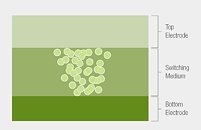
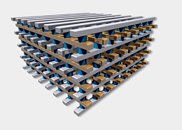
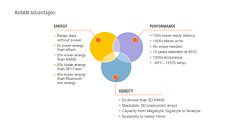
The companies expect this partnership to capture potential customers on Intel and Micron's 3D XPoint technology, which left users wondering where lofty, 1000x improvement performance claims had gone to. However, there's not much the partnership can achieve in that are, through that particular interface: at the type of speeds and IOPS that Crossbar's ReRAM can achieve, "(...) the NVMe interface becomes a large part of the delay", said Jim Handy, principal analyst at Objective Analysis.
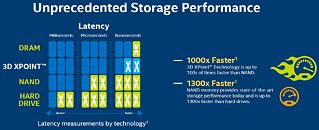
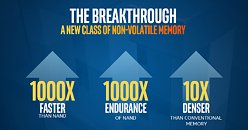
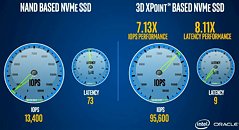
The key benefit of using ReRAM in an SSD is that it reduces storage controller complexity - and bottlenecks. It does so by removing large portions of the background memory accesses needed for garbage collection, and also by providing independent, atomic erasure by eliminating the need to build large-block memory arrays in flash designs. The companies know the market will be small: "It's going to be pretty expensive," said Handy, comparing it to the NV-DIMM market. "The current NV-DIMMS are more expensive than DRAM, they're way more expensive than SSDs, but offer blazing speed for people who want to pay for it," Handy said.
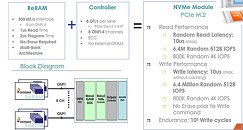
Handy said the Crossbar ReRAM-based SSDs will find a niche with customers willing to pay top dollar for persistence and performance, adding that Intel is selling Optane at a loss because it helps the company sell more expensive processors. SSDs with 3D NAND are not in any danger, said Handy. "They will be far more economical than anything made of out Crossbar ReRAM," he said.
View at TechPowerUp Main Site
This isn't the next evolution on SSD's - at least, not for the general consumer. ReRAM production and implementation costs will be leagues ahead of what current 3D NAND memory production entails, thus making this a niche product that is there for the customers that absolutely require the fastest throughput possible across a standard interface. In this case, NVMe is the choice - particularly, Mobiveil's NVMe, PCIe and DDR3/4 controllers can easily be adapted to accommodate the Crossbar ReRAM architecture, which is capable of six-million 512B IOPS below 10us latency.



The companies expect this partnership to capture potential customers on Intel and Micron's 3D XPoint technology, which left users wondering where lofty, 1000x improvement performance claims had gone to. However, there's not much the partnership can achieve in that are, through that particular interface: at the type of speeds and IOPS that Crossbar's ReRAM can achieve, "(...) the NVMe interface becomes a large part of the delay", said Jim Handy, principal analyst at Objective Analysis.



The key benefit of using ReRAM in an SSD is that it reduces storage controller complexity - and bottlenecks. It does so by removing large portions of the background memory accesses needed for garbage collection, and also by providing independent, atomic erasure by eliminating the need to build large-block memory arrays in flash designs. The companies know the market will be small: "It's going to be pretty expensive," said Handy, comparing it to the NV-DIMM market. "The current NV-DIMMS are more expensive than DRAM, they're way more expensive than SSDs, but offer blazing speed for people who want to pay for it," Handy said.

Handy said the Crossbar ReRAM-based SSDs will find a niche with customers willing to pay top dollar for persistence and performance, adding that Intel is selling Optane at a loss because it helps the company sell more expensive processors. SSDs with 3D NAND are not in any danger, said Handy. "They will be far more economical than anything made of out Crossbar ReRAM," he said.
View at TechPowerUp Main Site




